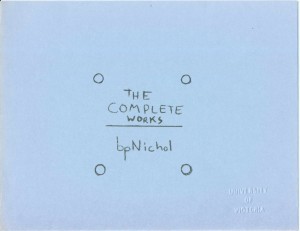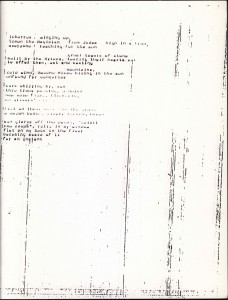Community
April 3, 2014
The bpNichol.ca Project: An Archive for Ephemera
*This post was written by Gregory Betts
In the avant-garde circuitry of Canadian small press publishing, the values of official verse culture are often inverted and reprogrammed. Whereas it seems natural in mainstream culture to value massive distribution, huge-scale production, and award-winning products, the authors who make the small press scene a coherent milieu are more likely to privilege precious objects that are individually made, circulated, and valued. This raises no problems for book reviewers or critics – they simply ignore what is sneeringly dismissed as “ephemera” – but it does raise an important problem for scholars of the avant-garde in the very limited access to primary materials. These items are often made in minuscule print-runs that quickly disappear into eccentrically organized private collections and only rarely get archived and made publicly available.
bpNichol is a definitive case of this type in Canada. On the one hand, his official verse culture position is convincing and significant: he published 24 books (depending on how you count them), many of which have been reprinted and remain in print, won the Governor-General’s Award, and has had the honour of an award and even a city road named after him. Two documentary films have been made of his work and influence, and a musical theatre interpretation of his collaborative sound poetry toured Canada in 2011. Outside of the spotlight, however, he also published thousands of “ephemeral” literary objects, including chapbooks, broadsides, comics, pillows, balloons, and much much more. Moreover, it is certainly the case that his ephemeral publications are more central to his poetics than his recognition within official verse culture. As the mark of an avant-garde reversal, his ephemera functions as a, if not the, central manifestation of his literary oeuvre.
The exquisite nature of the materiality of these textual objects presents a subsequent problem in attempting to address or consider the abundance of limited-run editions of his works. Reproductions or transcriptions come with the great loss of all the information encoded into the production choices made for his handmade works. How can one anthologize a two-page chapbook folded over in blue paper that sits small in the hand, for instance, or a single page with an enormous square cut out when the accompanying text of both refer to and depends upon those irreconcilable material features? As Lori Emerson and Darren Wershler write in their “Notes on the Poems” to The Alphabet Game: a bpNichol Reader, “Nichol’s print work demonstrates a particular and exacting commitment to the materiality of the printed page […] Attempting to fit such a heterogeneity into the framework of any book becomes what Nichol referred to in his own practice as translation. Translation never produces an exact equivalence” (318). For this reason, scholars of Nichol, and by extension of most avant-garde writers, must overcome the boundary of access to these rare and precious objects that evade the searching eye by nature.
What’s a poor scholar to do? Archives collect these objects, but struggle with the burden of locating and affording them. Scholars have to travel to incomplete archives, and are dependent on raising funds for that travelling to complete their work. In light of these fundamental problems, the digital facsimile reproduction represents an imperfect solution. They, too, are compromised translations of the work; no mere screen will replicate the strained feel of opening a staple-bound book. They do, however, present a unique opportunity for capturing the material presence of an avant-garde work. You can see the rust of the staples. You can see the inkmarks pressing through thin paper.
So just scan and dump them on the net? There are a number of digital archive models, and even a number of digital archive models for bpNichol’s work.
There is the PennSound archive that hosts .mp3 files of Nichol’s sound work and readings: http://www.writing.upenn.edu/pennsound/x/Nichol.php. These works are all presented with the permission of the Nichol estate, and are assembled haphazardly by the availability of recorded material and the willingness of volunteers to digitize and post work. Only limited information about the material is presented in the accompanying notes and descriptions.
There is the Ubu.com archive that presents scanned versions of complete texts: http://www.ubu.com/vp/bpNICHOL.html. These works are not presented with the permission of the Nichol estate; they are pirated editions. As with PennSound, they too are assembled haphazardly by the interests and availability of volunteers and come with even less information on each work.
Another model is provided by poet and publisher jwcurry with his Beepliographic Cyclopedia. While the Beepliography is primarily an offline project, curry uses digital facsimile to present individual Nichol textual objects as a Flickr photostream of (at present) 3, 477 photos: https://www.flickr.com/photos/48593922@N04/sets. Unlike the other two digital Nichol archives, the Beepligraphic Cyclopedia does not present entire works. Instead, each photo includes bibliographic information of a particular object and material evidence of its publication. Through this archive, you can learn about thousands of Nichol projects and to a certain degree see what each of them look like. It is uncertain whether these facsimiles are reproduced with the permission of the Nichol estate.
Beyond Nichol projects, American scholar and poet Johanna Drucker’s Artists Books Online presents a compelling example of a digital archive built around facsimile reproductions: http://www.artistsbooksonline.org/. Her model includes extensive notes about each entry, and full facsimiles of the works.
The bpNichol.ca digital archive portends to build from these models into a more comprehensive, more systemic record of works. With the permission and active support of the Nichol estate, the website aims to become the largest repository of complete works, photos, audio and video files on the internet. Even though the website is currently not available, previous incarnations of the website have already created an enormous database of digital facsimiles and documentary materials that await resurfacing. The ultimate ambition of the project, however optimistic that may be, is to create a complete digital set of Nichol works. The project will also include posthumous publications, previously unpublished works from the archives, and, eventually, critical responses to Nichol’s work.
Right now, the bpNichol.ca archive is not available. We are in the process of migrating to a newer version of the Drupal content management software – revealing a poignant hazard of digital life; the speed of anachronism in computers. As we update, we will be adding in new citations extensions that will allow us to capture historical information about the creation of a work and to associate multiple creative works with a single file, working under the assumption that most works contain a network of creative acts and incumbent copyrights. Reflecting the full nuance of digital publishing, we are working to allow artists (and rights holders) to better articulate their intentions for the creative use of their work.
Why is that a concern of the digital archive? Digital archives present copies of works in a way that is decidedly different from scholarly digital editions. Such projects work from primary materials and re-render original works through a systematic editorial process. A digital archive, in contrast, aims to facilitate editorial and pedagogical engagement with primary works. Eventually, scholarly digital editions might be developed, but that is not the current ambition of the website. Establishing and clarifying the copyright implications and boundaries of each work, however, will simplify the process for editors and scholars alike.
What’s next? After the current round of upgrades, the website will be relaunched hopefully in the Fall with significantly more works digitized, easier means of navigating the materials, and greater capabilities for scholars and general readers. We want people to be able to access Nichol’s ephemera while compromising the spirit of the original as little as possible. Ironically, though, the nature of the website is such that we will contradict the small press ethos by creating massive distribution and huge-scale production of Nichol’s work. In light of this contradiction, I take comfort from Nichol’s dictum that “language opens worlds, / little yields to unwilling readers” (“TTA 17”). Accordingly, everything on the website will be free, open, and awaiting your attention.
“everything at once
altogether
completely tangled together […]
everything at once
altogether & forgotten
completely remembered
thrown out” (“Extreme Positions” 4)
To commemorate the occasion of the website’s relaunch, on 7 November 2014, all of us associated with the project and many more will be gathering to celebrate what would have been Nichol’s 70th birthday at a one-day symposium at Brock University (in grateful affiliation with the EMiC project). The symposium will feature talks, small press workshops, roundtables, poetry readings, and more. Did somebody say Fraggle Rock dance your cares away party?

